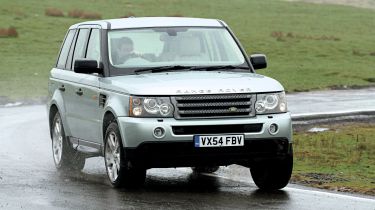Land Rover Range Rover Sport 4x4 review
Range Rover’s answer to the BMW X5 aims to mix sporty driving dynamics with the British firm’s legendary off-road ability.

Styling/Image
Despite being based on the same platform as the latest Land Rover Discovery, the Sport is unmistakably a Range Rover. Trademark design cues, such as the ‘floating’ roof panel and clamshell bonnet, combine with a lower windscreen and steeply angled tailgate. However, a raised ride height hints at the car’s considerable off-road ability. Buyers can choose from S, XS, SE, HSE and range-topping HST trims.
Interior/Practicality
There’s ample room for five on board the Sport, and all models come with electronically controlled air suspension, climate control and alloy wheels. The entry-level S gets cloth seats, while the rest of the line-up benefits from luxurious leather trim. Open the split tailgate and you’ll find a generous load bay that can be extended to 2,000-litres with the rear bench is folded flat. It can’t match the larger Range Rover top quality fixtures and fittings, but the comfortable cabin is still a great place to spend time.
Engines/Performance
Topping the engine line-up is the mighty supercharged 385bhp 4.2-litre V8 petrol engine, which propels the Sport from zero to 62mph in a scorching 7.6 seconds. But fuel consumption of 17.8mpg is the penalty for such high performance. Diesel fans have the choice of either 2.7-litre V6 or 3.6-litre V8 units, both of which are smooth and refined. The larger powerplant is our pick, as it will cover the standstill to 62mph benchmark in 9.2 seconds and return of 25.5mpg at the pumps.
Driving experience
Given its large size, the Sport is amazingly agile on twisting back roads. The steering is light, but the air suspension keeps body roll in check and the responsive six-speed automatic transmission serves-up smooth shifts. Only a slightly firm and fidgety ride lets the Range Rover down. The big Brit can still mix it in the mud, with the standard Terrain Response and Hill Descent Control providing the sort of off-road ability that the BMW X5 can only dream of.
Ownership Costs
Buy a Range Rover Sport and you should expect high running costs. Fuel consumption and emissions are a concern on all models - the entry-level 2.7-litre V6 oil-burner will struggle to achieve 30mpg, while a CO2 output of 265g/km drops it into the top VED tax bracket. However, this powerplant has the strongest residuals, retaining around 40 percent of its value after three years.
Safety/Environment
Eight airbags and electronic stability control feature on all versions of the Sport. Adaptive cruise control and bi-xenon headlamps are also available. The Range Rover might be safe, but it's certainly not green. All models fall into the top VED tax band, with the 4.2-litre supercharged car pumping out an unhealthy 374g/km of CO2. Of small consolation is the fact that the factory draws some of its power from wind turbines and that Land Rover offsets the carbon foot print of its new cars for the first 45,000 miles.
Our Choice: Range Rover Sport SE 3.6 TDV8







